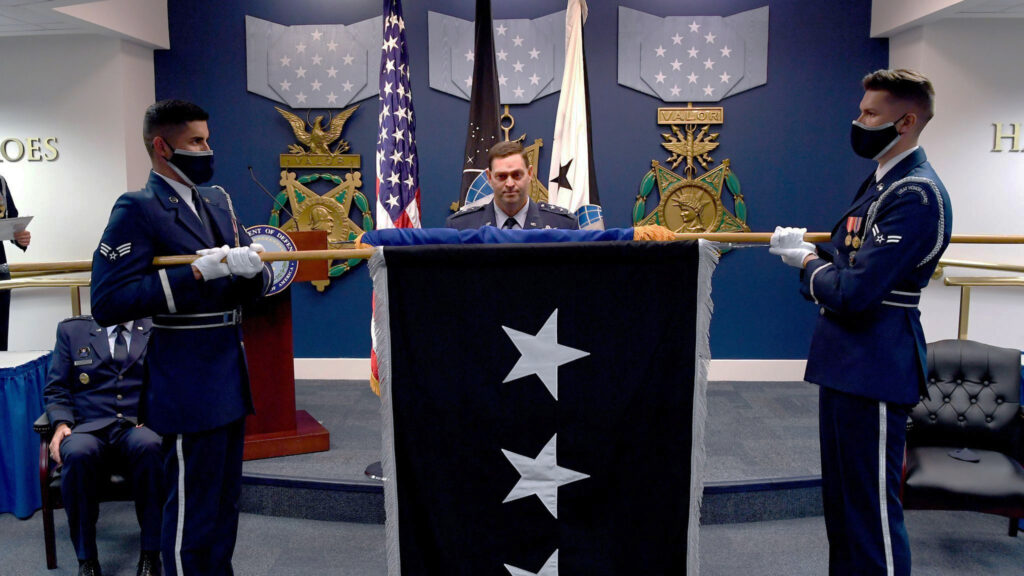
Lt. Gen. Chance (Salty) Saltzman (Photo: Air Force Public Affairs)
GEOINT 2022: Space Force is in the midst of an effort to assess warfighter needs for, and capability gaps in, space-based intelligence, surveillance and reconnaissance (ISR), Lt. Gen. Chance Saltzman said on Wednesday.
The service has “kicked off an ISR integrated process team, IPT, to focus and drive this initiative. The IPT, in coordination with the other services and combat support agencies will pursue efforts to capture joint space-based ISR and sensing requirements and propose paths to satisfy them,” said Saltzman, deputy chief of space operations for operations, cyber and nuclear.
“Our goal is to ultimately develop a comprehensive set of needs and gap analysis with traceable documentation of the joint warfighter requirements for space,” he added. “The foundations of our space based ISR enterprise will have profound effects not only in the space domain, but in all warfighting domains.”
Saltzman told reporters after his presentation at the USGIF GEOINT 2022 symposium near Denver that the effort is being led by Lt. Gen. Bill Liquori, deputy chief of space operations for strategy, plans, programs, requirements and analysis. Thus, he said he was unable to provide details about the detailed plan of action and the schedule.
However, he noted that the IPT process is just a first step — designed to survey and assess the current ISR landscape.
“The step one is: what are the needs? What are the requirements? What do we have? And then where’s the gap analysis? Again, we don’t want to spend any money, you know, in a redundant way,” Saltzman said during the press briefing. “You have to figure out, where do we want to spend our money? What’s being done effectively through commercial? What’s being done by other capabilities? And then, where are the gaps and shortfalls? Let’s talk about spending our money there.”
The next step then is to develop an investment strategy to fill the gaps discovered. “It would be probably wishful thinking to say, ‘Hey, turns out there’s no gaps, we have everything we need,'” he said wryly.
The effort is being done with full cognizance that the Intelligence Community (IC) — primarily the National Reconnaissance Office (NRO) and the National Geospatial-Intelligence Agency — already are providing ISR to military commanders as part of their combat support missions. And Space Force therefore is working closely with the spy agencies.
The Space Force “recognizes the long-standing and solid” relationship the Pentagon has with NRO and NGA and wants “to be sure our efforts do not compete with but instead complement the work already being done to identify integrate and make available commercial products and data to meet national security needs,” he said.
“We are collaborating specifically with even broader members of the IC to make sure we’re collecting all the requirements as well. And then and then evaluating capabilities,” he elaborated during the press conference.
In May, Space Force chief Gen. Jay Raymond revealed a previously classified program to develop a satellite-based ground moving target indicators (GMTI) — noting that it was part of the service’s nascent plan to take on the job of procuring space-based ISR for the other services. GMTI radars use a pulsing technique to discriminate moving targets, such as enemy tanks and mobile missile launchers, from stationary objects and clock their velocities based on their Doppler shift.
Up to now, the Department of the Air Force’s primary GMTI platform has been the aging Joint Surveillance Target Attack Radar System (JSTARS) aircraft fleet. The new space-based radar would be part of the solution for replacing JSTARS.
But the question of separating the roles and missions of the IC and the Space Force, as well as the Space Force’s remit from that of the other services, in particular the Army, has already piqued congressional concerns. The 2022 National Defense Authorization Act limits all spending on GMTI efforts, including at NRO, to not greater than 75% of their planned annual budgets pending a report by the Vice Chairman of the Joint Chiefs of Staff Adm. Christopher Brady.
The NDAA demands that to Congress cover “all established and planned efforts to provide air- and space-based ground moving target indicator capability to identify, eliminate, and prevent redundancies of efforts across the Department of Defense.”
Finally, Saltzman stressed that the Space Force intends to engage industry as it moves ahead and is looking to the private sector for innovative solutions to future ISR needs.
“We must find ways to meet our global national security needs and expand our partnerships with the growing sector of commercial GEOINT,” he said.
Of course, ramping up use of commercial providers of remote sensing and geospatial intelligence also has been the mantra of both the NGA and the NRO for the past several years. How the responsibility for acquiring space-based ISR from industry is sorted is the job of the new(ish) IC Commercial Space Council, led by NGA’s head of commercial operations David Gauthier. While the Space Force is a member of that council, it does not have voting rights, whereas the NRO and NGA do.






















